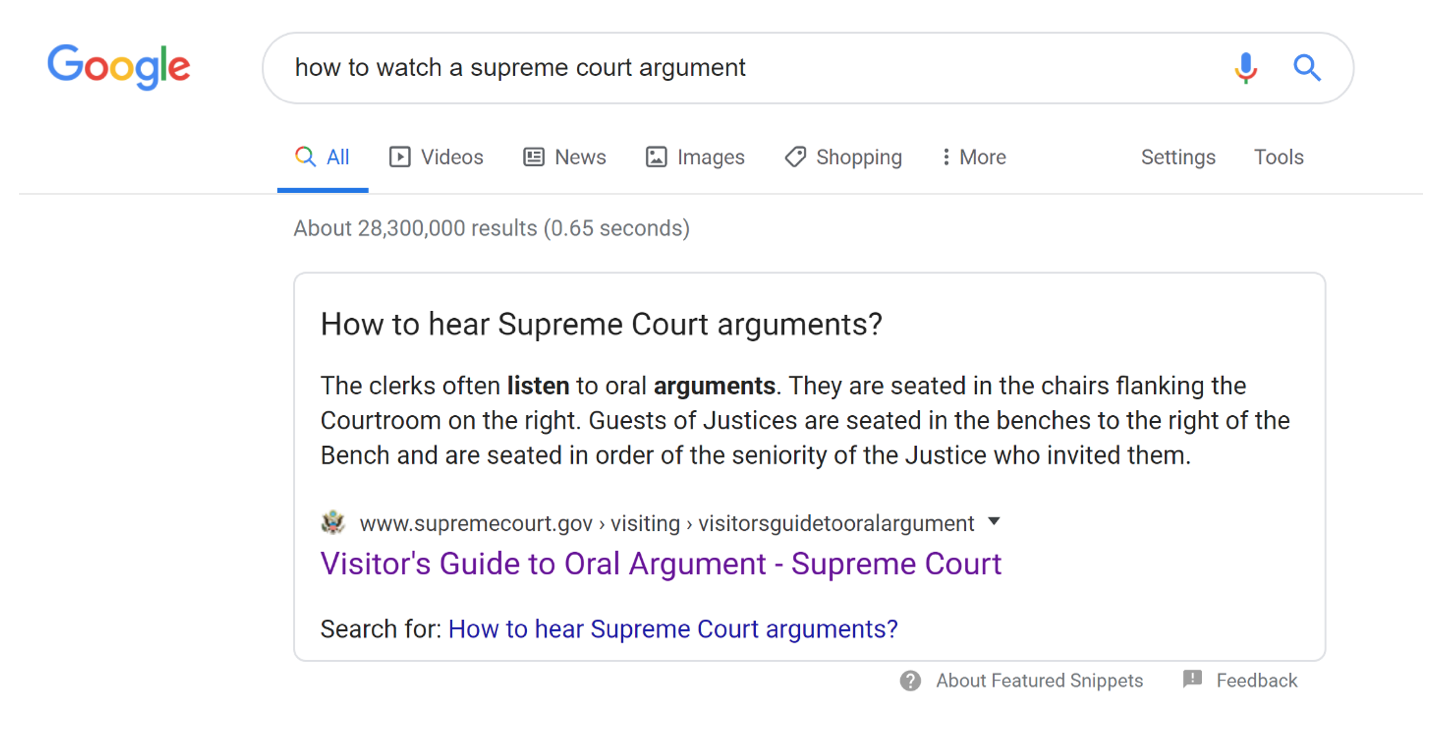Courtroom access: An online quest: “how to watch a Supreme Court argument”

If you wanted to find out how to see the most powerful court in the United States in action, you would probably turn to the internet first.

The first result that pops up comes from the official website of the Supreme Court and looks promising: Visitor’s Guide to Oral Argument. The last expandable header on the page, “Courtroom seating,” provides some useful information:
- Two lines form on the Supreme Court’s plaza for the first oral argument of the day, which begins at 10 a.m. — a line for attending the full argument and the three-minute rotating line.
- Seating begins at 9:30 a.m. for those attending the full argument and at 10:00 a.m. for those in the rotating line.
The website’s Frequently Asked Questions include “What time should I start lining up to attend oral argument?” The court declines to make a specific judgment but advises that the line may form before the building opens. “Visitors may begin lining up … as early as they feel comfortable.”
 The court’s website doesn’t indicate how many seats are available for the general public wanting to attend a full argument – usually at least 50 – or that tickets for those 50 seats are distributed by court police at 7:30 a.m. If this is where you stopped your research, the only metric you would have for when you should arrive is that the line forms some time before 9:30 a.m. To figure out how early to get to the court, then, you would need to look further.
The court’s website doesn’t indicate how many seats are available for the general public wanting to attend a full argument – usually at least 50 – or that tickets for those 50 seats are distributed by court police at 7:30 a.m. If this is where you stopped your research, the only metric you would have for when you should arrive is that the line forms some time before 9:30 a.m. To figure out how early to get to the court, then, you would need to look further.
One of the top search results is an article from the American Bar Association intended to help lawyers check off “attending a Supreme Court oral argument” from their “career bucket list.” The author advises first-time visitors to “arrive early,” because the last time he attended oral argument, a group of law students were camped out by 5 a.m., making them the first ones in line.
In a post on this blog, Steven Mazie, the Supreme Court reporter for The Economist and a professor at Bard High School Early College Manhattan, offers advice gleaned from a visit to the court with a group of 20 students. Warning visitors to “gird for battle,” Mazie recounts that he and his students stood in line for two hours and 45 minutes (without bathroom access) and waited inside the building for another two and a half hours just to sit in the back of the courtroom. The marshal’s office at the court had advised Mazie that arriving between 7 and 7:30 a.m. would be sufficient on a normal day. After scoping out the line earlier in the term, though, Mazie calculated that his group would need to arrive at 5 a.m. He ended up adjusting their arrival time after getting intel from the check-in desk at his hotel that another student group was making similar plans. By arriving at 4:45 a.m., Mazie and his students secured spots 6-28 in line. The other group arrived just after 6 a.m. and did not get a chance to see the nation’s highest court in action that day.
If you don’t trade secrets with your concierge, message boards offer some helpful advice for visitors to the court. On reddit, users share stories of failure and success with the conclusion that you should arrive between 5 a.m. and 6 a.m. Reddit users also link to great resources, like this online guide by George Washington University Professor Zachary Wolf. Wolf recommends that his students arrive by 6 a.m. “even for relatively low-interest cases,“ but says his “general view is that if you’re going to set an alarm and drag yourself out of bed early anyway, you might as well make it as early as possible, so it won’t all be in vain.”
Newspapers have documented the difficulty of accessing the court, though usually on days when the court is hearing a high-profile case. For example, according to The Washington Post, “[s]ome of those in line for Masterpiece Cakeshop v. Colorado Civil Rights Commission, the case of the Colorado baker who refused to make a wedding cake for a same-sex couple, waited for four days.” An op-ed in The Baltimore Sun recounted a trip to the Supreme Court for some less-closely watched arguments. Tulsa, Oklahoma, attorney Kevin Keller had the opportunity to travel to Washington, D.C., when he found out his wife was running a marathon. An avid court follower, Keller followed best practice and arrived at 5:45 a.m. for a day of low-profile contracts cases only to be cut off by a large group of businessmen from China. The next day, for a higher-profile set of cases, Keller arrived at 3:45 a.m. and was the fifth or sixth person in line.
For those attempting diligent research on when to arrive, search results are varied, official answers are few and the conclusions visitors draw are all different. Large groups are not required to register in advance, so even someone acting on good information can end up locked out of the nation’s highest court.
Posted in Courtroom Access